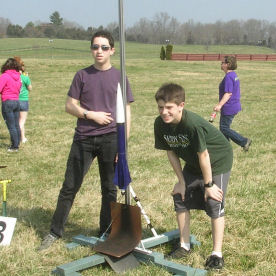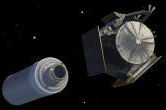|
|
Seven
members
(Teams 13198 and 13200) and several adults traveled to the Virginia launch site on
Saturday, March 17. It was a beautiful day, with wind under 5 mph.
We used the 7ft launch rail for all the launches. We had
some very nice launches and all rockets were recovered. Each team did three launches including one TARC qualification launch.
We have one more final qualification launch in March. Objectives
- Teams 13198 and 13200 complete at least one qualification launch.
- Team 13200 will use the new altimeter.
Lessons
- We angled the rail just a few
degrees with the wind, with changes as the wind diminished . The flights were very straight.
- On the second test, Team 13198 switched to a thin 18" chute to reduce weight.
- On their third (qualification) test, Team 13198 switched out their shock cords
because they were getting tangled and frayed. Good move. The other teams need to continually check
rocket elements and repair if suspicious..
- On their third test, Team 13200 had the parachute melt a little and not deploy
correctly. They need to better protect their chute from the ejection sparks
- On their second test, Team 13200 had the bottom egg crack. It was a
qualification flight so they were DQed. They need to protect the bottom egg better. They lost the top
egg on their third test because of the near free fall of the cargo unit.
- Team 13198 had several Quest
igniter failures and switched to using copperheads. We used up most of the Quest igniters.
- Both teams used the new
altimeters. Both had serious spikes at ejection and at landing. We need to think about this
issue.
- We weighed our motors and
eggs. The motors were all very close in weight. The eggs varied
between 58 and 62 grams. The teams used this difference to adjust total rocket weight. While weighting
the motors and eggs may not have made much difference, attention to detail is always a good thing.
- We still need a stool for the 7ft launch
rail, although Team 13200 overcame their deficiency in height.
- We need to be very careful in weighting our rockets (or anything) and do it two or
three times with Tare in between. When you make adjustments due to weight, you need to have accurate
data.
| |

Team 13200

Team 13198 |
|
|
Launches
|
Rocket |
Engine |
Cargo |
Cargo Recovery |
Booster Recovery |
Weight |
Results |
Comments |
 |
Black
test 1
video |
E30-7T |
2 eggs,
altimeter M |
18" chute |
connected |
380g |
778ft, 50sec |
Nice flight
Score 31 |
Black
test 2
video |
E30-7T |
2 eggs,
altimeter M |
18" chute thin |
connected |
375g |
782ft, 41sec |
Nice flight
Score 24 |
Black
test 3
video |
E30-7T |
2 eggs,
altimeter M |
18" chute thin |
connected |
375g |
812ft, 43.57sec |
Nice flight
Qualification
Score 12.00 |
 |
Blue
test 1
no
video |
E30-7T |
2 eggs,
altimeter N |
24" X-chute |
connected |
380g |
731ft, 43sec |
Nice flight, but too low |
Blue
test 2
video |
E30-7T |
2 eggs,
altimeter N |
24" X-chute |
connected |
370g |
851ft, 55sec |
Looked like a nice flight, but too high and one egg cracked
Qualification
Score DQ |
Blue
test 3
video |
E30-7T |
2 eggs,
altimeter N |
24" X-chute |
connected |
375g |
854ft, 29sec |
Looked like a nice flight, but chute did not deploy correctly, slightly
melted. |
Altimeter Data
New Altimeters (Excel format)
 |



